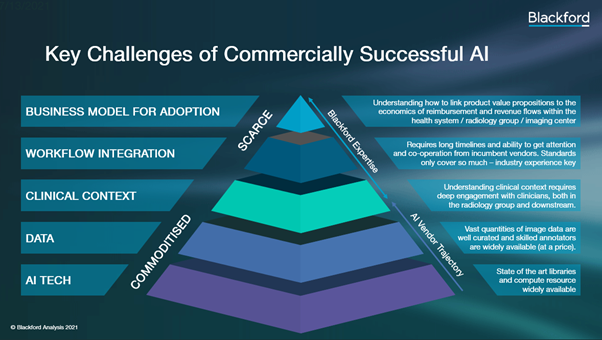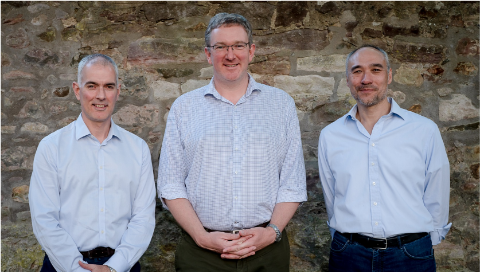Blackford Analysis
Blackford CEO Ben Panter speaks out on the key challenges in making AI a commercial success in medical imaging.
While investment in medical imaging AI continues to scale to new peaks, with the exception of a few cases, true commercial adoption in healthcare remains limited. While some of this delay is due to the impact on budgets and access caused by the COVID-19 pandemic, there are also underlying issues that challenge adoption. There are several elements that are critical to the successful development and subsequent adoption of AI, and it's helpful to think about where the pinch points exist. It can be useful to think about this in terms of the layers of a pyramid, with each layer representing an increasingly more difficult challenge for AI developers. Technology, data, context The base of the pyramid represents the underlying AI technology, which, through global effort across many industry and research sectors, is now highly developed and, in many cases, available as open source libraries. The cloud, and particularly the availability of GPUs in the cloud, means that effectively limitless computational resource is available at a very low cost.
The next tier reflects the challenge of accessing data for training and validation. In our field of medical imaging, any sizeable hospital has huge quantities of data. We often hear that "data is the new oil", but the reality in the analogy is that data is far more valuable when refined than in its crude form. The tools are in place for this processing though - annotation can be gained through natural language processing of accompanying reports, assessment by trained radiologists or external annotation services. The next step up for AI developers is establishing clinical context. This is where successful applications begin to be differentiated – there is a big difference in clinical value between an algorithm that detects nodules and one that detects, measures, characterizes and classifies nodules, and generates a report that references the relevant clinical guidelines (and is configurable to any local variations on them). Most of the medical imaging AI companies that have survived in the market thus far have reached this point.
Workflow integration The next challenge is significantly harder – to deliver the information into radiology workflow in a way that benefits the patient by adding value to both radiologist and referrer. Many vendors have attempted to replicate the reading environment with their own tools, but this isn't a scalable approach. While radiologists might, at a push, be able to shift context between a couple of reading environments, using a separate viewer for every application is unfeasible. Besides the viewer, integration into the worklist for notifications and triage, and downstream into the reporting system is critical – along with HL7 to access deeper information about the reason for the order, rather than just the information contained in DICOM. Few AI algorithms are governed by well-defined standards, and often the only way to achieve integration is by encountering systems in the wild and developing alongside them. Large vendors struggle to find the time to engage with startups unless a high-value customer demands it or personal connections can be leveraged.
Business model The final, and hardest, tier of the pyramid represents the generation of a business model for adoption by a practice or facility. Although there are a handful of nascent reimbursement routes, the majority of AI products require careful construction of value propositions that are highly dependent on the reading environment, payer demographics and structure of the practice with relation to its referrers. There are relatively few AI products in medical imaging that have successfully demonstrated repeatable revenue in this top tier, hence why establishing a business model for adoption is the pinnacle of all the challenges facing AI creators in medical imaging seeking to commercialize their models.
Target the top As a platform for the management and deployment of medical imaging AI, Blackford has vast experience of both the top tiers of the pyramid.
Technology, data, context The base of the pyramid represents the underlying AI technology, which, through global effort across many industry and research sectors, is now highly developed and, in many cases, available as open source libraries. The cloud, and particularly the availability of GPUs in the cloud, means that effectively limitless computational resource is available at a very low cost.
The next tier reflects the challenge of accessing data for training and validation. In our field of medical imaging, any sizeable hospital has huge quantities of data. We often hear that "data is the new oil", but the reality in the analogy is that data is far more valuable when refined than in its crude form. The tools are in place for this processing though - annotation can be gained through natural language processing of accompanying reports, assessment by trained radiologists or external annotation services. The next step up for AI developers is establishing clinical context. This is where successful applications begin to be differentiated – there is a big difference in clinical value between an algorithm that detects nodules and one that detects, measures, characterizes and classifies nodules, and generates a report that references the relevant clinical guidelines (and is configurable to any local variations on them). Most of the medical imaging AI companies that have survived in the market thus far have reached this point.
Workflow integration The next challenge is significantly harder – to deliver the information into radiology workflow in a way that benefits the patient by adding value to both radiologist and referrer. Many vendors have attempted to replicate the reading environment with their own tools, but this isn't a scalable approach. While radiologists might, at a push, be able to shift context between a couple of reading environments, using a separate viewer for every application is unfeasible. Besides the viewer, integration into the worklist for notifications and triage, and downstream into the reporting system is critical – along with HL7 to access deeper information about the reason for the order, rather than just the information contained in DICOM. Few AI algorithms are governed by well-defined standards, and often the only way to achieve integration is by encountering systems in the wild and developing alongside them. Large vendors struggle to find the time to engage with startups unless a high-value customer demands it or personal connections can be leveraged.
Business model The final, and hardest, tier of the pyramid represents the generation of a business model for adoption by a practice or facility. Although there are a handful of nascent reimbursement routes, the majority of AI products require careful construction of value propositions that are highly dependent on the reading environment, payer demographics and structure of the practice with relation to its referrers. There are relatively few AI products in medical imaging that have successfully demonstrated repeatable revenue in this top tier, hence why establishing a business model for adoption is the pinnacle of all the challenges facing AI creators in medical imaging seeking to commercialize their models.
Target the top As a platform for the management and deployment of medical imaging AI, Blackford has vast experience of both the top tiers of the pyramid.
- With over a decade of clinical deployments under our belts, we have a mixture of standards-based and proprietary integrations into every step of radiology workflow, across a wide range of vendor partners. Where legacy systems cannot support the required functionality, we have alternatives that can slot in to augment them as seamlessly as possible.
- Our wide range of customers, combined with our experience at selling a huge array of clinical applications, allows us to gain insight and cross-pollinate our sales processes, understanding what classes of product pricing models work in which environments and why.











